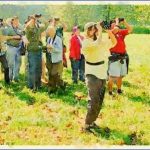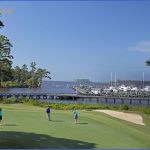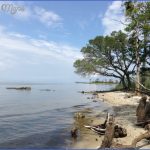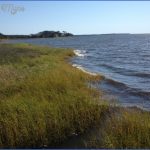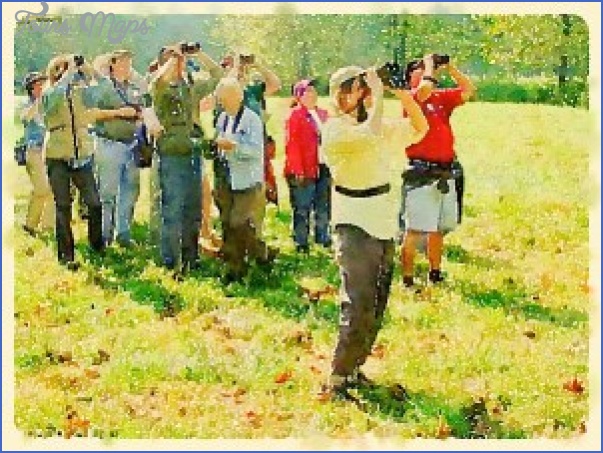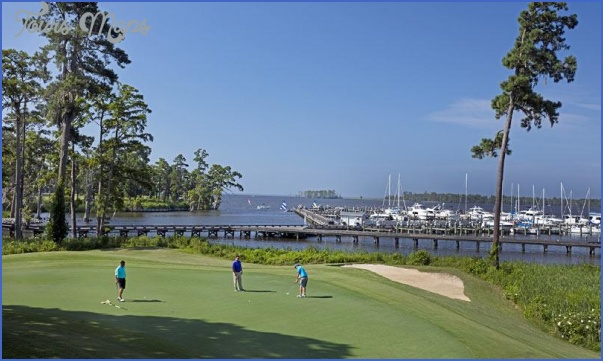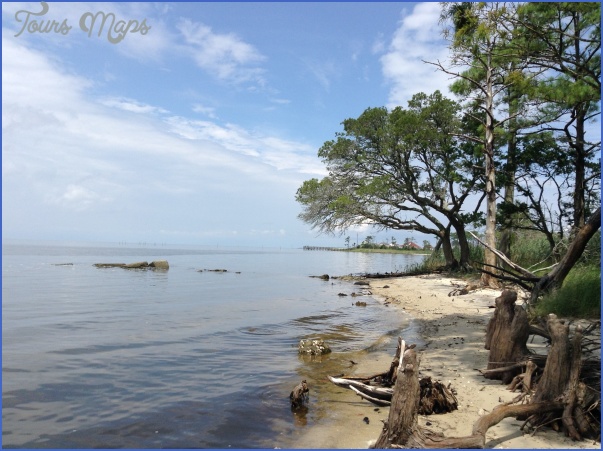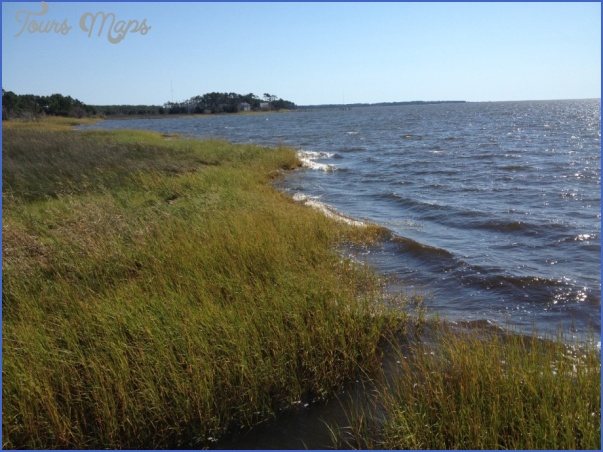For many travelers along U.S. Highway 264, the road is nothing more than the quickest route to the Outer Banks. In their haste to get to the beach, they whiz right by striking scenery, towns rich with historical significance, and some of the finest wildlife viewing in the state.
Washington, where we begin our route, changed its name from Forks of the Tar in 1776, becoming according to townspeople America’s first town named after George Washington. Ideally situated on the Pamlico River, the town became an important port during the Revolution when other Southern ports were under control by the British. Washington also saw considerable action during the Civil War. While no longer a significant port, the town still boasts an impressive collection of late-nineteenth- and early-twentieth-century architecture. And its waterfront is still a bustle of activity with sailors, joggers, bicyclers, sightseers, and sweethearts watching the sunset over the river.
As you drive out of Washington, you leave behind just about everything urban for the remainder of the route. For the next hundred miles, you’ll encounter just a couple of stoplights and fast-food restaurants.
At Pantego, you’ll want to make a side trip to Pocosin Lakes (formerly Pungo) National Wildlife Refuge. The first of four wildlife refuges on the route, Pocosin encompasses some 110,000 acres of wildlife habitat. Over forty species of mammal call the refuge home, including black bear, bobcat, coyote, white-tailed deer, and the federally endangered red wolf, as do a diversity of reptiles and amphibians. But it’s the more than two hundred species of bird that make the refuge famous. The best time to visit is from early December through February, when you can see large numbers of waterfowl, raptors, and red-winged blackbirds. This is probably the best location in the East to see snow geese. Up to eighty thousand of the birds overwinter at the refuge, creating an astonishing show at sunrise when they fly into the fields after roosting for the night.
A few miles from Pantego is the small town of Belhaven, home to the most unusual museum in the state, if not the country. The Belhaven Memorial Museum, occupying the second floor of the historic 1911 City Hall building, displays a collection of, well, just about everything. There’s a pig preserved in a jar, German helmets and a machine gun from World War II, a human skeleton, thirty thousand buttons, a ten-pound tumor removed from a local woman, a display of toenails and tonsils, Civil War memorabilia (no doubt there’s stuff from every war), seashells, clothes, books, pottery, rocks, archeological artifacts, antique dolls, and a dress worn by a 700-pound woman. The museum literally has tons and tons of . . . stuff. The museum even has two fleas (yes, fleas) dressed as a bride and groom, viewable under a magnifying glass.
Start out in Washington on U.S. 264. Drive east to U.S. 64 near Manteo.(115 miles)
Snow geese are a common sight at Pocosin Lakes National Wildlife Refuge.
Thousands of red-winged blackbirds flock at Pocosin Lakes National Wildlife Refuge.
Swan Quarter is definitely worth a detour off the main route. The tiny maritime village remains largely untouched by modern trappings, its residents still earning a living from the sea and the surrounding farms. Be sure to drive out past the seafood houses to the viewpoint over Swanquarter Bay. Swanquarter National Wildlife Refuge occupies much of the marsh and associated waters in the area, but it is not user-friendly to those without a boat.
Mattamuskeet National Wildlife Refuge, just up the road from Swan Quarter, is among the best wildlife refuges in the country for scenic beauty and wildlife viewing. The refuge consists of open water, marsh, timberlands, and crop fields, with the vast majority being Lake Mattamuskeet. At eighteen miles long and six miles wide, it’s the largest natural lake in North Carolina. The lake averages only a little more than two feet in depth and the lake bed is said to have soil that is among the richest in the world. Many early attempts were made to drain the lake, the grandest effort culminating in 1916 with the completion of the massive pumping station that still stands on the south side of the lake.
A visit to the refuge should begin on NC Highway 94 with a drive along the six-mile causeway that transects the lake. Numerous breaks in the vegetation provide good views of the lake and birdlife. The best view along the causeway is from a boardwalk extending a short distance into the lake, with a viewing gazebo at the end. A small island of cypress trees sits in the lake in front of the overlook, and you can often see bald eagles in the trees. In November, you can always see waterfowl of some kind on the lake. This view is especially scenic at sunrise and sunset.
After exploring along the causeway, turn off NC 94 onto the refuge entrance road. The two-mile drive offers exceptional wildlife viewing opportunities, particularly in early morning and late evening. Near the end of the road, just before the old lodge, is the refuge headquarters, where you can pick up a map and ask questions. From here, you can walk around and explore the lodge building. When viewing the lodge in a photograph, persons not familiar with the history of the lake often mistake the 120-foot smokestack for a lighthouse.
Lake Landing Historic District, designated by the National Register of Historic Places, stretches along several miles of U.S. 264 near Lake Mattamuskeet and follows backroads through the communities of Middleton, White Plains, and Nebraska. The district features numerous nineteenth- and early-twentieth-century farmhouses, churches, and
abandoned stores. This is plantation country, with fields of corn, cotton, and soybeans stretching to the horizon. It’s also white-tailed deer country. Drive through here at dawn and dusk and the question is not will you see any deer, but whether you can slow down quickly enough when they cross the road in front of you. Slow speeds and alert eyes are called for. The maritime village of Engelhard, a few miles northwest of the historic district, also features interesting historical architecture, as well as scenic amenities associated with the waterfront.
Most of the nearly forty-mile stretch between Engelhard and U.S. 64 passes through the fourth wildlife refuge on this route, Alligator River. Like all national wildlife refuges, its mission is to provide habitat and safe haven for wildlife. But Alligator River National Wildlife Refuge also offers superb recreational opportunities. Its dirt roads and walking trails provide access for wildlife viewing, and a network of paddling trails takes canoeists and kayakers into the backcountry for an unforgettable experience. Lucky visitors might hear the howls of the endangered red wolf, reintroduced at Alligator River in the late 1980s.
The smokestack on the massive pumping station at Lake Mattamuskeet resembles a lighthouse.
The best access to Alligator River NWR is not directly along our route. When you get to U.S. 64 (route’s end), turn left and drive a little over four miles to the Creef Cut Wildlife Trail, where you can pick up a refuge map and other information. A right turn on U.S. 64 brings you to Manns Harbor, the start of Route 24.
A DRIVE THROUGH THE ALBEMARLE PENINSULA Photo Gallery
Maybe You Like Them Too
- The Best Cities To Visit in The World
- World’s 10 Best Places To Visit
- Coolest Countries in the World to Visit
- Travel to Santorini, Greece
- Map of Barbados – Holiday in Barbados

